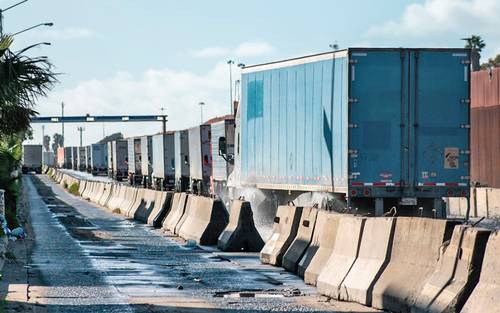The interruptions for more than 36 hours in the merchandise dispatch system paralyzed part of international trade in the country and, preliminarily, it is expected that it will take a week to relieve the bottleneck.
This Thursday hundreds of trailers began to move through the customs areas, while the National Customs Agency of Mexico (ANAM) reported that they are performing a comprehensive system evaluation
and waited until the last minute for a complete explanation of what happened.
After a day and a half of interruptions in the system to process the clearance of merchandise, on the night of February 7, the Nuevo Laredo customs reported that, by instructions from the central area
starting at 10 p.m., operations in the loading area of the International Bridge III of World Trade
through which it is estimated that 40 percent of the exchange of goods between Mexico and the United States passes, which on an average day is 1.3 billion dollars.
The paralysis lasted at least 9 hours. A new circular to users reported that from 7 in the morning the export platform was reopened and the usual hours were reestablished. However, the system remained slow. The fault, whose visibility exploded at this border point, was not only replicated along the strip between Mexico and the United States; Customs clearance by land, air and sea progressed in dribs and drabs due to the failure in the system.
Losses in Texas reach $660 million
At least 20 thousand export and import operations were suspended at the Nuevo Laredo International Bridge. The mayor of Laredo, Texas, Víctor Treviño, pointed out that on the US side alone, economic losses totaled 660 million dollars. At midday, the cargo trucks stranded since Wednesday began to move forward, but traffic was slow and the lines extended up to 24 kilometers.
The Confederation of Industrial Chambers (Concamin) indicated that so far it does not have an estimate of the losses caused to the different industrial sectors by the closure of the International Bridge. The biggest problem is that Much of the merchandise paralyzed for hours is perishable, so there are serious consequences for food safety.
he warned.
On this point, the Mexican Meat Council led the criticism. The authorities have not given certainty as to when the operation will be restored, nor the causes of the failures. These serious delays in imports and exports generate losses for the entire value chain of the different sectors with an impact on the final consumer; since if it is not resolved there could be a problem with the supply of raw materials for food production.
.
Over the course of Thursday, the merchandise clearance process was gradually reestablished at the customs of Tijuana, Baja California; Manzanillo, Colima; Nuevo Laredo, Tamaulipas, and Ciudad Juárez, Chihuahua, reported authorities from those entities.
Given the slowness of the system and the backlog already accumulated, restoring the flow of the service could take a week. At the Port of Manzanillo there were hundreds of cargo vehicles waiting to pass, so the port authorities announced the extension of service hours to speed up procedures starting this Thursday and until February 13.
At the gate of the Otay checkpoint, in Tijuana, the setbacks began intermittently on Tuesday and total paralysis became evident on Wednesday. Dozens of trucks made long lines, reported Guadalupe Sandoval, president of the Association of Independent Transporters of Baja California AC.
